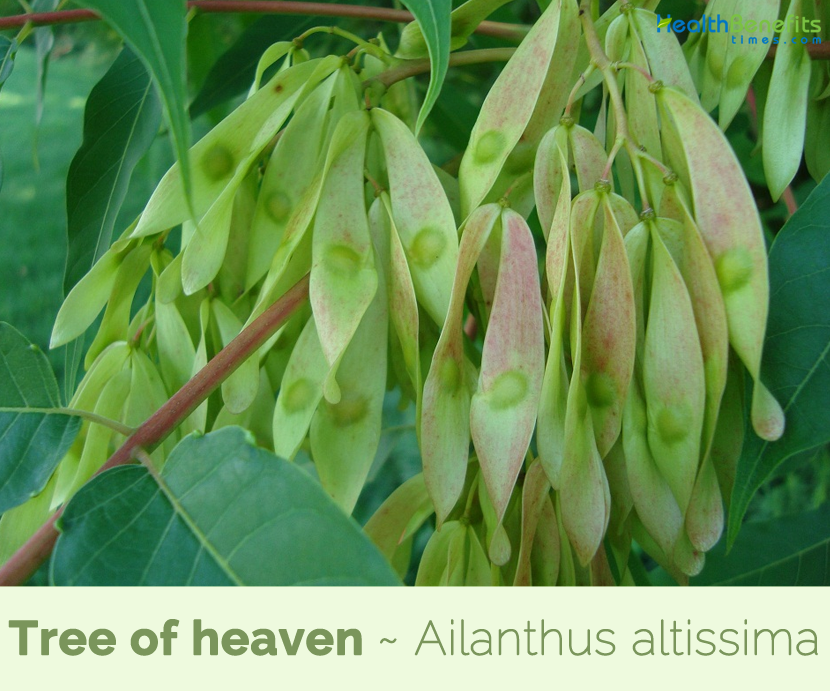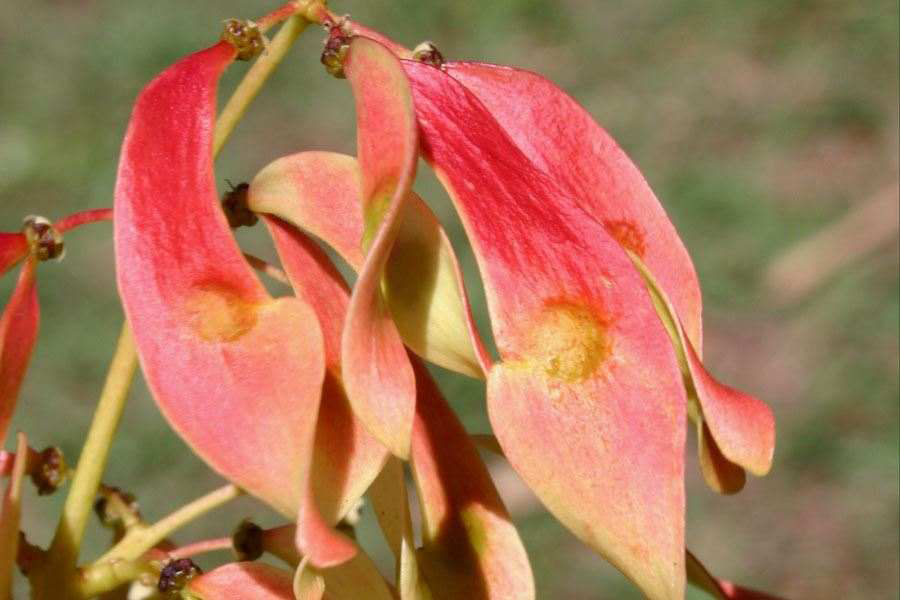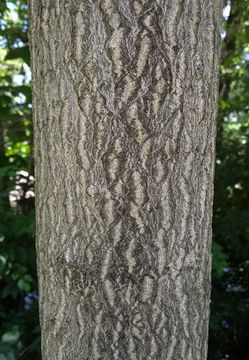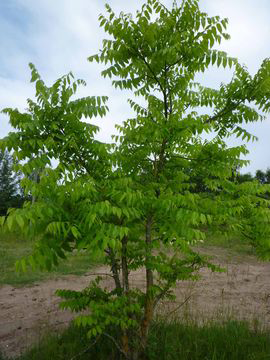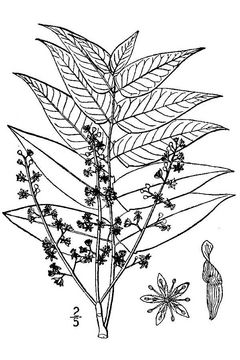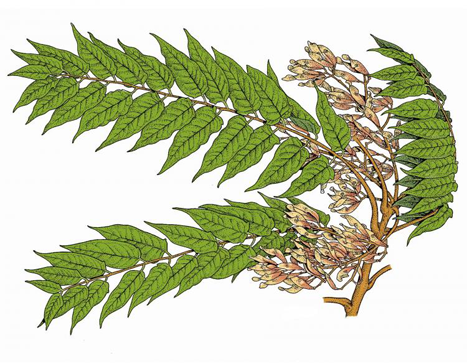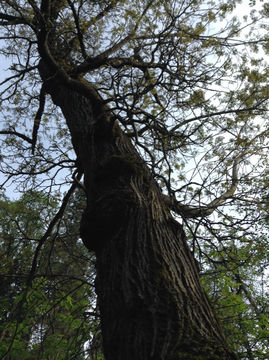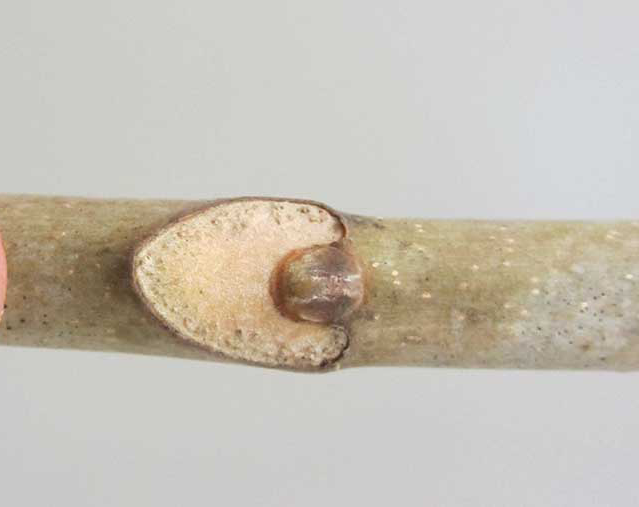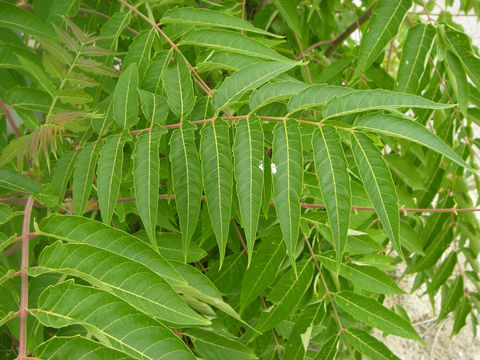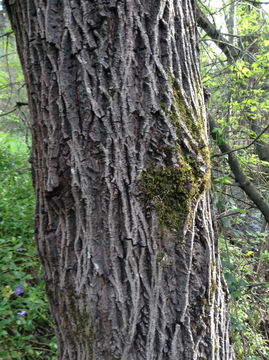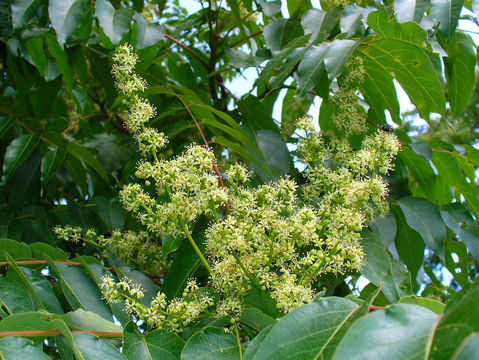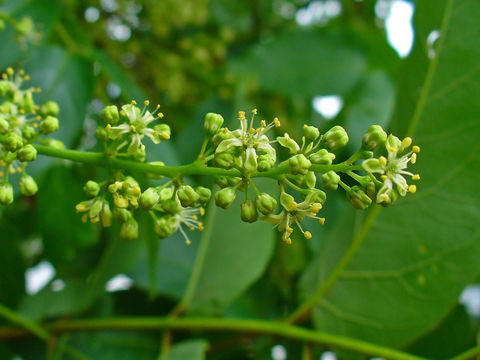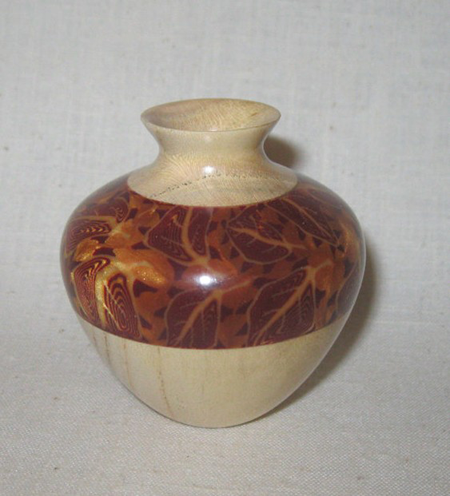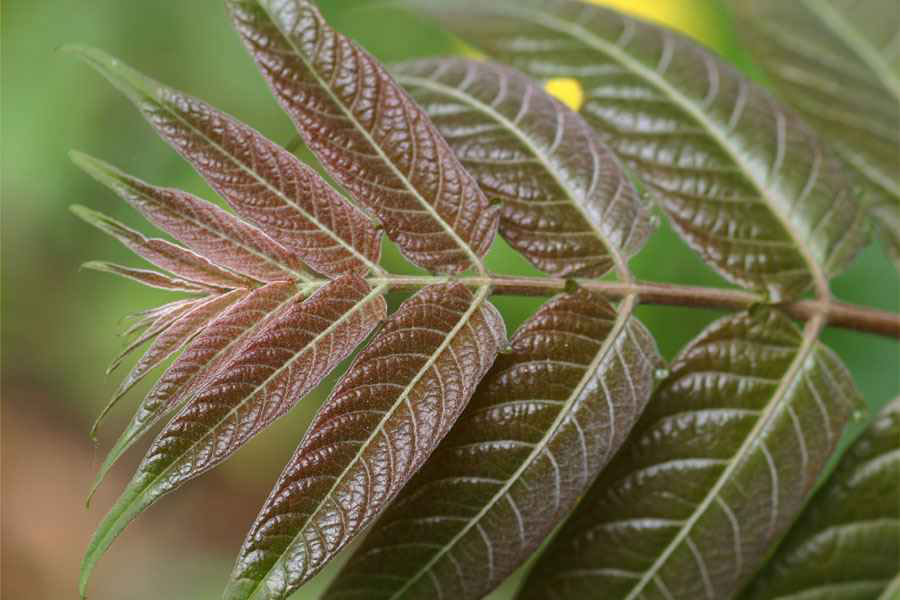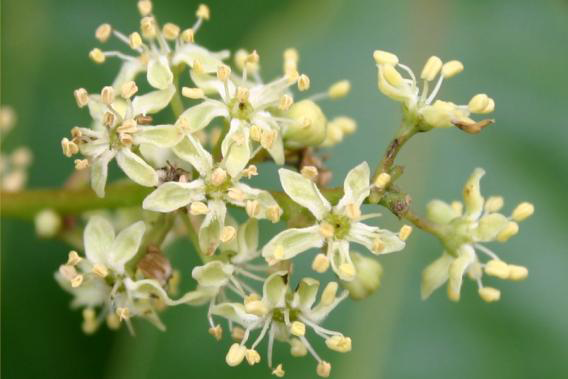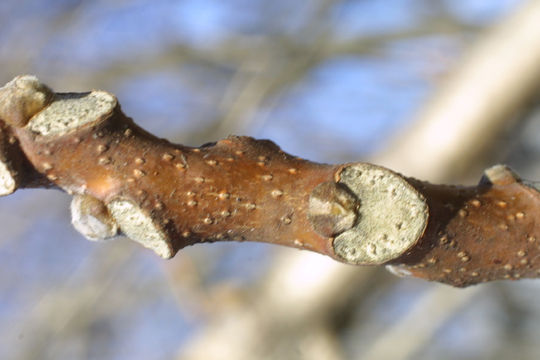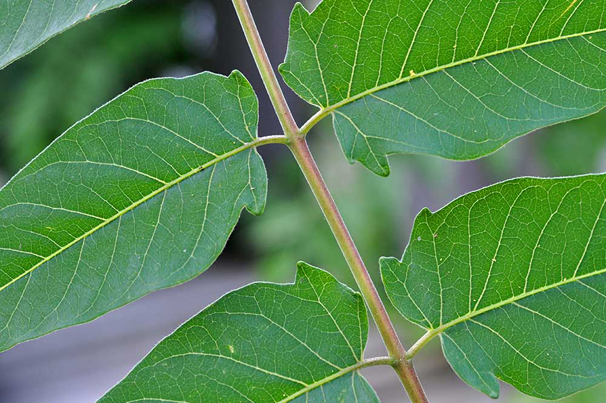Plant description
Tree of heaven is a medium-sized, fast growing, deciduous, exotic invasive tree that may reach 60 to 70 feet (18-21 m) in height, 80 feet (24 m) in crown width, and 20 feet (6 m) in trunk diameter at maturity. The tree is found growing in woodland edges and openings, thickets, riverbanks, vacant lots, landfills and dumps, gravelly back alleys, areas along roads and railways, fence rows, and urban waste areas. It tolerates a wide range of soil nutrient levels and other soil conditions. Best growth occurs on nutrient-rich, loamy soils, but tree-of-heaven establishes in nutrient-poor soils. The plant has taproot and several large lateral roots. Barks are normally smooth and light green when young, eventually turning to light brown to gray somewhat rougher with light tan fissures as the tree ages resembling the skin of a cantaloupe.
Twigs
The twigs of tree-of-heaven are alternate on the tree, stout, greenish to brown in color, and lack a terminal bud. They have large V- or heart-shaped leaf scars. Twigs easily break to expose the large, spongy, brown center, or pith. Branches are light to dark gray in color, smooth, lustrous, and contain raised lenticels that become fissures with age. The ends of the branches become pendulous.
Leaves
Leaves are large, odd- or even-pinnately compound, and arranged alternately on the stem. They range in size from 30 to 90 cm (0.98 to 2.95 ft.) in length and contain 10–41 leaflets organized in pairs, with the largest leaves found on vigorous young sprouts. The rachis is light to reddish-green with a swollen base.
Leaflets
Leaflets are ovate-lanceolate with entire margins, somewhat asymmetric and occasionally not directly opposite to each other. Each leaflet is 5 to 18 cm (2.0 to 7.1 in) long and 2.5 to 5 cm (0.98 to 1.97 in) wide. They have a long tapering end while the bases have two to four teeth, each containing one or more glands at the tip. The upper sides of leaflets are dark green in color with light green veins, while the undersides are a more whitish green. Petioles are 5 to 12 mm (0.20 to 0.47 in) long. The lobed bases and glands differentiate it from similar sumac species.
Flower & fruit
Flowers are small and appear in large panicles up to 50 cm (20 in) in length at the end of new shoots. Individual flowers are yellowish green to reddish in color, each with five petals and sepals. The sepals are cup-shaped, lobed and united while the petals are valvate (i.e. they meet at the edges without overlapping), white and hairy towards the inside. They appear from mid-April in the south of its range to July in the north. It is dioecious, with male and female flowers being borne on different individuals. Male trees produce three to four times as many flowers as the females, making the male flowers more noticeable. Additionally, the male plants emit a foul-smelling odor while flowering to attract pollinating insects. Female flowers contain ten (or rarely five through abortion) sterile stamens (stamenoides) with heart-shaped anthers. The pistil is made up of five free carpels (i.e. they are not fused), each containing a single ovule. Their styles are united and slender with star-shaped stigmas. The male flowers are similar in appearance, but they lack a pistil and the stamens do function, each being topped with a globular anther and a glandular green disc.
Male flowers wither away; the female flowers are replaced by single-seeded samaras that mature during the late summer or fall. Individual samaras are about 2.5 cm long (1 in) and 1 cm (0.39 in) broad and are initially light green, but later become yellowish or reddish green, and finally become tan to brown. Each samara has two elongated membranous wings and a central seed; the wings are often slightly twisted. Individual seeds are about 5 mm in diameter, ovoid, and slightly flattened. The samaras are distributed by the wind or water.
History
The plant is said to have first introduced into the United States in the Philadelphia area in 1784. Immigrants later introduced tree-of-heaven to the West Coast in the 1850s. It was initially valued as an urban street tree and was extensively planted in the Baltimore and Washington, D.C., area. From these areas, tree-of-heaven has spread and become a common invasive plant in urban, agricultural, and forested areas. Today this plant is found in many parts of the world due to its wonderful health promoting benefits.
Types
There are three varieties of Ailanthus altissima
- Altissima var. altissima: It is one of the popular varieties and is native to mainland China.
- Altissima var. tanakai: This variety is common to northern Taiwan highlands. It differs from the type in having yellowish bark, odd-pinnate leaves that are also shorter on average at 45 to 60 cm (18 to 24 in) long with only 13–25 scythe-like leaflets. It is listed as endangered in the IUCN Red List of threatened species due to loss of habitat for building and industrial plantations.
- Altissima var. sutchuenensis: This variety differs in having red branchlets.
Traditional uses and benefits of Tree of heaven
- It is capable in curbing ailments relating to memory like memory loss, unable to concentrate, difficulty in learning and recalling things.
- It is also suitable in case of confusion and Recklessness i.e. performing actions, without caution.
- It is productive in countering ailments associated to the head like extreme headaches accompanied by Dizziness, Vertigo or Nausea.
- It also aids congestive headaches, which comprises hot head along with watering of Eyes.
- It is also helpful in case of Mental Disturbance and in controlling the degree of Anxiety and Fatigue.
- It is proficient in counteracting the problem of Epilepsy, whose outcome is disorientated operations of the Brain Cells.
- It is capable in ceasing problem of Insomnia i.e. Sleeplessness.
- Ailanthus is a good herbal treatment for countering fever due to Typhoid, whose root cause is either bacterial infection or adulterated food and water.
- It is also worthwhile in combating fever in case of Malaria, an outcome of mosquito bites.
- Its bark works efficiently in treatment of conditions like Anemia i.e. insufficiency of Blood.
- It is beneficial in curbing troubles relating to Eyes like conjunctivitis, burning sensation in the eyes causing Pain and blurry vision due to Purulent discharge.
- It is effective in treating Nasal complaints like dryness in nose, congestion in nostrils, inflamed mucuos Membrane accompanied by Sneezing and Loss of Smell.
- It is appreciated in tending to Ear disorders like pain in the ear at the time of swallowing, due to swelling in the Salivary gland.
- It is fruitful in combating oral problems like ulcers in the gums and mouth and bleeding gums.
- Ailanthus is advantageous in treatment to throat related problems like dryness, irritation and pain in the Throat.
- It also helps in providing relief from painful tonsils, which makes breathing and food intake difficult.
- It is effective in taking care of heart complaints like Rapid and Slow Heart pulse, thus, it in turn, aids in normalization of Heart Rate.
- It is suitable in treatment of respiratory ailments like bronchitis, asthma, quick and irregular breathing due to cough and cold.
- Ailanthus is a good herbal treatment for curing skin afflictions like miliary skin rash, which forms small or large red patches on the Skin, in clusters.
- It is beneficent in taking care of ailments related to the Stomach like, extreme pain in the Stomach, along with burning sensation and feeling of empty Stomach.
- It is effective in curbing bowel movement disorders like pain at the time of bowel and uneasy and hard Bowels.
- It is fruitful in removal of Tapeworms, which are live worms, in the Intestines.
- It is efficient in arresting Loose Stool i.e. Dysentery and Diarrhea, leading to weakness in the Body.
- It is worthwhile in curbing discomfort and pain due to Cramps during Menstruation.
- It is profitable in combating women related problems like Leucorrhoea, which leads to thick white yellowish Vaginal discharge.
- It is helpful in treating and overcoming sexually transmittable disease like Gonorrhea, which can be encountered by both the genders.
- Ailanthus is beneficent in tending and arresting bleeding from the Uterus.
- It is valuable in treating Urinary disorders like insufficient amount of urine, unconscious discharge of Urine and improper Urine Flow.
- It is used as an astringent, antispasmodic, anthelmintic, and parasiticide.
- Fresh stem bark is used to treat diarrhea and dysentery.
- Root bark is used for heat ailments, epilepsy, and asthma.
- Fruits are used to regulate menstruation and treat ophthalmic diseases.
- Leaves are an astringent and used in lotions for seborrhea and scabies.
- Tree-of-heaven extracts have antibacterial, antioxidant, and anti-inflammatory properties.
- Roots, leaves and bark are still used today in traditional Chinese medicine, primarily as an astringent.
- Leaves when taken internally make one incoherent and sleepy.
- When used externally they can be effectively used to treat boils, abscesses and itches.
- Young leaves of ailanthus, catalpa and peach tree are crushed together and the resulting liquid when applied to the scalp help to stimulate hair growth.
- Bark is said to have cooling and astringent properties and is primarily used to treat dysentery, intestinal hemorrhage, menorrhagia and spermatorrhoea.
- Tincture of the root-bark has been used successfully in treating cardiac palpitation, asthma and epilepsy.
- Ailanthus altissima has potent anti-anaphylactic and anti-inflammatory properties.
- Root and stem bark are antispasmodic, astringent, bitter, cardiac depressant, diuretic, emetic, febrifuge, rubefacient and vermifuge.
- Nauseatingly bitter herb, it is used internally to treat malaria and fevers, it also slows the heart rate and relaxes spasms.
- Bark is a popular remedy for dysentery and other complaints of the bowels in China.
- Tincture of the root-bark has been used successfully in the treatment of cardiac palpitations, asthma and epilepsy.
- Tree-of-heaven is a folk remedy for asthma, cancer, diarrhea, dysentery, dysmenorrhea, dysuria, ejaculation (premature), epilepsy, eruption, fever, gonorrhea, haematochezia, leucorrhoea, malaria, Metrorrhagia, sores, spasms, spermatorrhoea, stomachic, tumors of the breast (China), and wet dreams.
- Leaves, bark of the trunk, and roots are put into a wash to treat parasitic ulcers, itch, and eruptions.
- Root bark is used in the treatment of coughs, gastric and intestinal upsets in Korea.
- Stem bark is emenagogue.
- Fruit is used in the treatment of bloody stools and dysentery.
- Extracts from the plant are bactericidal.
- Tree is used in homeopathic remedies for cancer.
- Resin extracted from the roots and leaves is a revulsive or vesicant.
Other Uses
- Tree-of-heaven has been widely planted as an ornamental because it grows quickly, can be trained into an attractive shape, and has attractive foliage and fruits.
- Tree-of-heaven provides shade, medicine, wood, clothing, and food for humans.
- Tree-of-heaven is grown commercially as a host for Attacus cynthia, a silkworm that produces coarse, durable silk in China.
- Tree-of-heaven is a food for honeybees worldwide.
- Tree-of-heaven wood looks like ash wood in appearance and quality. It is easily worked with tools and glue, and takes a finish well.
- All parts of the plant have a unique strong odor that is frequently likened to peanuts, cashews, or rotting cashews.
- Tree of heaven is a very rapidly growing tree, possibly the fastest growing tree in North America.
- Pale yellow, close-grained and satiny wood of ailanthus has been used in cabinet work.
- It is flexible and well suited to the manufacture of kitchen steamers, which are important in Chinese cuisine for cooking mantou, pastries and rice.
- It is also considered a good source of firewood across much of its range as it moderately hard and heavy, yet readily available.
- Wood is also used to make charcoal for culinary purposes.
- Yellow dye is obtained from the leaves.
- Leaves and wood are high in cellulose and are used in paper-making.
- Crushed leaves and flowers are insect-repellent.
- Plant parts, when steeped in water, are said to yield an insecticidal solution.
- When plants are put into marshy areas they drain the soil and thus remove mosquito breeding sites.
- Plants have extensive root systems and sucker freely; they can be used in soil-stabilization program.
- Plants can be grown as a tall hedge.
- Disagreeable odor of the plant may cause some people to feel sleepy.
- Female trees are prolific seeders with the potential to produce more than 300,000 seeds annually.
Precautions
- Plant is possibly poisonous.
- Male flowers have potentially allergenic pollen.
- Leaves are toxic to domestic animals.
- Gardeners who fell the tree may suffer rashes.
- Odor of the foliage is intensely disagreeable and can cause headache and nausea, rhinitis and conjunctivitis.
- Pollen can cause hay fever.
- It needs to be used under the supervision of a qualified practitioner since the bark readily causes vomiting.
- It may cause fatigue, nausea, vomiting, high blood pressure, depression, Arthritis.
References:
https://www.itis.gov/servlet/SingleRpt/SingleRpt?search_topic=TSN&search_value=28827#null
https://davesgarden.com/guides/pf/go/1699/
http://www.hear.org/pier/species/ailanthus_altissima.htm
https://npgsweb.ars-grin.gov/gringlobal/taxonomydetail.aspx?id=2072
https://pfaf.org/user/Plant.aspx?LatinName=Ailanthus+altissima
https://www.cabi.org/isc/datasheet/3889
http://www.missouribotanicalgarden.org/PlantFinder/PlantFinderDetails.aspx?kempercode=a847
http://www.floracatalana.net/ailanthus-altissima-mill-swingle
https://www.botanical.com/botanical/mgmh/t/trehea28.html
https://plants.usda.gov/core/profile?symbol=aial
http://www.theplantlist.org/tpl1.1/record/kew-2626815
https://en.wikipedia.org/wiki/Ailanthus_altissima
https://hort.purdue.edu/newcrop/duke_energy/Ailanthus_altissima.html
https://www.nwcb.wa.gov/weeds/tree-of-heaven
Comments
| Tree of heaven Quick Facts | |
|---|---|
| Name: | Tree of heaven |
| Scientific Name: | Ailanthus altissima |
| Origin | Northern and central China, Taiwan and northern Korea |
| Colors | Initially light green, but later become yellowish or reddish green, and finally become tan to brown |
| Shapes | Single-seeded samaras about 2.5 cm long (1 in) and 1 cm (0.39 in) broad |
| Taste | Nauseating, astringent, bitter taste |
| Health benefits | Folk remedy for asthma, cancer, diarrhea, dysentery, dysmenorrhea, dysuria, ejaculation (premature), epilepsy, eruption, fever, gonorrhea, haematochezia, leucorrhoea, malaria, Metrorrhagia, sores, spasms, spermatorrhoea, stomachic, tumors of the breast (China), and wet dreams |
| Name | Tree of heaven |
|---|---|
| Scientific Name | Ailanthus altissima |
| Native | Northern and central China, Taiwan and northern Korea |
| Common Names | China-sumac, Chinese tree-of-heaven, Tree of heaven, Copal tree, Stinktree, Tree-of-heaven, Varnishtree, Chinese sumac, Ailanthus, Skink tree, Varnish tree, Ailanto-da-China, China-sumac, Stinking shumac, stinking sumac, Swingle |
| Name in Other Languages | Afrikaans: Hemelboom Arabic: Shajarat el- sama Catalan: Vernis del japo Chinese: Dà guǒ chū shù (大果樗树), chou chun (臭椿), bai chun, chun shu, Chun Pi Danish: Skyrækker Dutch: Hemelboom English: China-sumac, Chinese tree-of-heaven, Tree of heaven, Copal tree, Stinktree, Tree-of-heaven, Varnishtree, Chinese sumac, Ailanthus, Skink tree, Varnish tree, Ailanto-da-China, China-sumac, Stinking shumac, stinking sumac, Swingle Finnish: Haisujumaltenpuu French: Faux-vernis du japon, Vernis de la Chine, Verno, Ailante glanduleux, Faux vernis du Japon, Ailante glanduleux, frêne puant, arbre des dieux, arbre du ciel German: Chinesischer Götterbaum, Götterbaum, Drüsiger Götterbaum Italian: Ailanto, Albero del paradise Norwegian Bokmål: Gudetre Nynorsk, Norwegian: Gudetre Occitan: Ailant, Vernís del japon Portuguese: Ailanto Russian: Ajlant vysočajšij South Africa: Hemelboom Spanish: Ailanto, barniz falso de Japan, árbol del cielo, zumaque falso Swedish: Gudaträd, himmelstraed |
| Plant Growth Habit | Medium-sized, fast growing, deciduous, exotic invasive tree |
| Growing Climates | Woodland edges and openings, thickets, riverbanks, vacant lots, landfills and dumps, gravelly back alleys, areas along roads and railways, fence rows, and urban waste areas |
| Soil | Tolerates a wide range of soil nutrient levels and other soil conditions. Best growth occurs on nutrient-rich, loamy soils, but tree-of-heaven establishes in nutrient-poor soils |
| Plant Size | May reach 60 to 70 feet (18-21 m) in height, 80 feet (24 m) in crown width, and 20 feet (6 m) in trunk diameter at maturity |
| Root | Taproot and several large lateral roots |
| Stem | Smooth stems |
| Bark | Smooth and light green when young, eventually turning to light brown to gray somewhat rougher with light tan fissures as the tree ages resembling the skin of a cantaloupe |
| Twigs | Alternate on the tree, stout, greenish to brown in color, and lack a terminal bud. They have large V- or heart-shaped leaf scars. The twigs easily break to expose the large, spongy, brown center, or pith. |
| Branch | Light to dark gray in color, smooth, lustrous, and containing raised lenticels that become fissures with age. The ends of the branches become pendulous |
| Leaf | Large, odd- or even-pinnately compound, and arranged alternately on the stem. They range in size from 30 to 90 cm (0.98 to 2.95 ft.) in length and contain 10–41 leaflets organized in pairs |
| Leaflets | Ovate-lanceolate with entire margins, somewhat asymmetric and occasionally not directly opposite to each other. Each leaflet is 5 to 18 cm (2.0 to 7.1 in) long and 2.5 to 5 cm (0.98 to 1.97 in) wide. |
| Flowering Periods | July to August |
| Flower | Dioecious plant meaning that male and female flowers occur on separate plants. Flowers occur in large terminal clusters and are small and pale yellow to greenish |
| Fruit Shape & Size | Single-seeded samaras about 2.5 cm long (1 in) and 1 cm (0.39 in) broad |
| Fruit Color | Initially light green, but later become yellowish or reddish green, and finally become tan to brown |
| Seed | 1-to-2-inch-long twisted samara, or wing. There is one seed per samara. The samaras are found in clusters, which often hang on the tree through winter. |
| Flavor/Aroma | Nutty or burned nut odor |
| Taste | Nauseating, astringent, bitter taste |
| Plant Parts Used | Stem, bark, root, leaves |
| Lifespan | Ranging from 30 to 70 years |
| Season | September to November |
| Varieties/types |
|
| Culinary uses |
|


